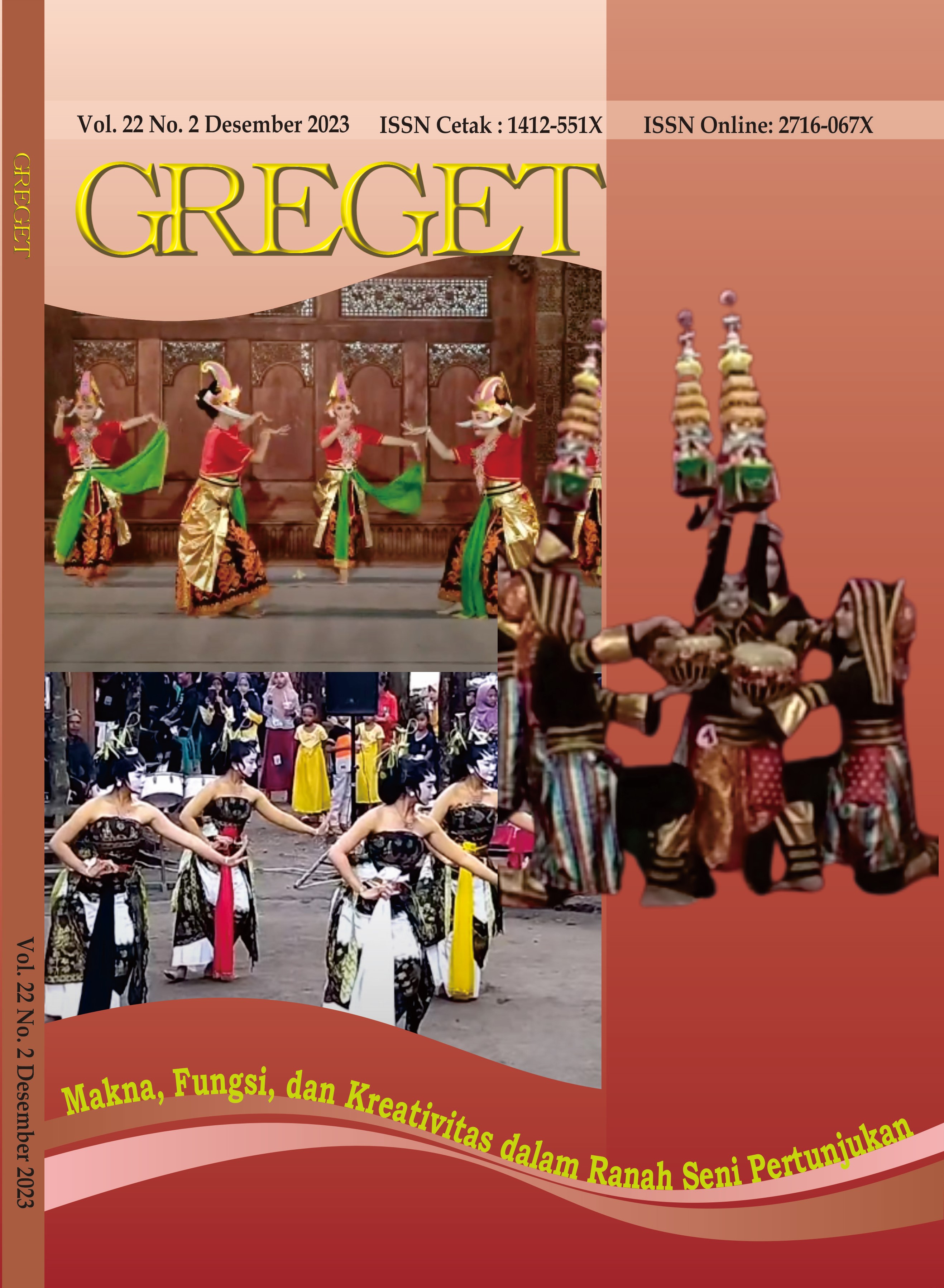TARI SRIMPI BLONYO MALELA: WUJUD DEKONSTRUKSI SRIMPI BLONYO
Main Article Content
Abstract
This research examines the Srimpi Blonyo Malela’s dance work as a result of the deconstruction of the Srimpi Blonyo dance. The Srimpi Blonyo Malela’s dance work is the result of a deconstruction of the Srimpi Blonyo dance. The meaning of deconstruction itself is to dismantle the establishment through various texts and cultural contexts. This is research uses qualitative research and the explanation is analytical descriptive. The literature review and literature study for this research were taken from oral and written references. The results of the research on Srimpi Blonyo Malela's dance work found a form of overall renewal of the Srimpi Blonyo dance except for make-up and clothing. Deconstruction or dismantling is carried out on elements such as the content of the story line, movement arrangement, floor pattern structure, number of dancers, props used and musical accompaniment. These elements were created through the creativity, imagination and exploration of deconstructors. The Srimpi Blonyo Malela dance is based on the mythical belief of Dewi Sri and Raden Sadana, which makes people aware of the ecology of the universe which is worked out symbolically through the medium of movement, clothing and sound. Both are central figures in agricultural and fertility mythology, often associated with the balance of the universe. Apart from that, giving values regarding belief in Dewi Sri and Raden Sadana in some Javanese communities is a way of expressing gratitude to God Almighty.
Downloads
Article Details

This work is licensed under a Creative Commons Attribution-ShareAlike 4.0 International License.
Copyright
Authors who publish with GREGET agrees to the following terms:
- Authors retain copyright and grant the journal right of first publication with the work simultaneously licensed under a Creative Commons Attribution-ShareAlike 4.0 (CC BY-SA 4.0) that allows others to share the work with an acknowledgment of the work's authorship and initial publication in this journal.
- Authors are able to enter into separate, additional contractual arrangements for the non-exclusive distribution of the journal's published version of the work (e.g., post it to an institutional repository or publish it in a book), with an acknowledgment of its initial publication in this journal.
- Authors are permitted and encouraged to post their work online (e.g., in institutional repositories or on their website) prior to and during the submission process, as it can lead to productive exchanges, as well as earlier and greater citation of published work.
References
Hadi, Y. S. (2003). Aspek-aspek Koreografi Kelompok. eLKPI.
Hadi, A. W. M. (2016). Hermeneutika, Estetika, dan Religiusitas. Sadra Press
Hardiman, B. (2015). Seni Memahami Hermeneutik dari Schleiermacher sampai Derrida. PT Kanisius.
Hasan. (2022). Prinsip Dekonstruksi dalam Proses Kreasi Seni Kolase Surealisme. Jambura: Jurnal Seni dan Desain, 2(2).
Humphrey, D. (1983). The Art of Making Dance (Sal Murgiyanto Penerj.). Direktorat Kesenian Jakarta.
Kirana, D. (2017). Visualisasi Papat Kiblat Lima Pancer dalam Bentuk Tari Dramatik. Core: Jurnal Mahasiswa Universitas Negeri Surabaya, 1, 1-13.
Lexy, J. M. (1993). Metodologi Penelitian Kualitatif. PT Remaja Rosdakarya.
Nazir, M. (1998). Metode Penelitian. Ghalia Indonesia.
Palmer, R. E. (2022). Hermeneutika Interpretasi dalam Pemikiran Schleiermacher, Dilthey, Heideger, dan Gadamer. IRCiSoD
Soedarsono, R. M. (1972). Komposisi Tari Elemen-Elemen Dasar. ASTI Yogyakarta.
Soemaryatmi. (2007). Wiraga Tunggal. ISI Press.
Sugiharto, B. (2021). Teori Dekonstruksi. LPPM UNS.
Sumaryanto, T. 2007. Pendekatan Kuantitatif dan Kualitatif dalam Pendidikan Seni. UNNES Press.
Sutopo, H. B. (2006). Metodologi Penelitian Kualitatif Dasar teori dan terapannya dalam penelitian. Universitas Sebelas Maret.
Suwondo, T. (1997). Mitos Dewi Sri pada Masyarakat Jawa. Kebudayaan 14, 63-76.
